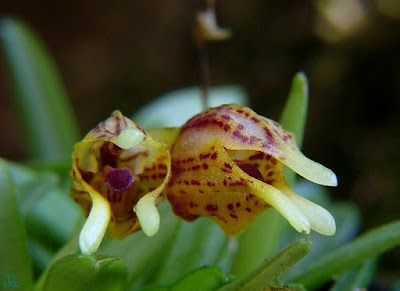Diodonopsis hoeijeri is fund in west central Colombia and southeastern Ecuador on tiny branches of short trees in wet cloud forests at elevations of 1500 to 2600 meters. Thomas Höeijer with Stig Dalström was discovered the species north of Gualaquiza, Ecuador (elevation 1600 m), in 1984. This orchid has also been collected from the Cordillera del Condor (elevation 1500 to 1600 m), and east of the pass between Loja and Zamora (elevation 2600 m). E. Valencia also collected this species at a more distant site, at an elevation of 1600 to 1800 m in the Department of Antioquia, Colombia.
Diodonopsis hoeijeri also called as Hoeijer's Diodonopsis, Masdevallia hoeijeri, Pteroon hoeijeri, is a species of the genus Diodonopsis. This species was described by Alec Melton Pridgeon & Mark Wayne Chase in 2001. This small species is named in honor of Thomas Höeijer of the Bergius Botanical Garden Museum in Stockholm.
IDENTIFY DIODONOPSIS HOEIJERI ORCHID PLANT
Diodonopsis hoeijeri is fund in west central Colombia and southeastern Ecuador on tiny branches of short trees in wet cloud forests at elevations of 1500 to 2600 meters. Thomas Höeijer with Stig Dalström was discovered the species north of Gualaquiza, Ecuador (elevation 1600 m), in 1984. This orchid has also been collected from the Cordillera del Condor (elevation 1500 to 1600 m), and east of the pass between Loja and Zamora (elevation 2600 m). E. Valencia also collected this species at a more distant site, at an elevation of 1600 to 1800 m in the Department of Antioquia, Colombia.
It is a mini-miniature sized, cool to cold growing epiphyte with slender, suberect ramicauls enveloped basally by 2 to 3 thin, tubular sheaths and carrying a single, apical, coriaceous, narrowly obovate, subacute, gradually narrowing below into the sub-petiolate base leaf.
Hoeijer's Diodonopsis blooms in the spring and summer on a slender, weak, suberect, 1 to 1.5 cm long, single flowered inflorescence arising from low on the ramicaul with a bract near the base and a thin, infundibular floral bract. The flower features a short, greenish yellow, inflated, sepaline tube, with red-brown speckling on the veins and short yellow tails. The apex of the lip is verrucose and dark red.
DIODONOPSIS HOEIJERI ORCHID PLANT CARE AND CULTURE
Cultural information should only be used as a guide, and should be to be adapted to suit you. Your physical location; where you grow your plants, how much time you have to devote to their care, and many other factors, will need to be taken into account. Only then can you decide on the cultural methods that best suit you and your plants.
Light:
Diodonopsis hoeijeri like good light, but not direct light. 17000 - 22000 lux is a good amount of light. About 70-90% shade is recommended in summer and 25% shade to full sun in winter. It will flower better if receive plenty of light and leaves are pale green rather than dark green when in heavy shade.
Temperature:
Hoeijer's Diodonopsis grown well in cool growing conditions from 5°C to 25°C. Ideally in winter they like a minimum of 10°C in and a maximum of 13°C. In summer the optimum range is 13 to 20°C. The temperature should not exceed 25°C and temperatures consistently above 30°C will weaken the plants and they may drop their leaves. Ensure 6-12°C day/night difference to aid flower formation.
Humidity:
This orchid prefer high humidity in summer near 75-80% and may need a humidifier over summer. Keep air circulation at all times to prevent water staying on leaves as this will encourage leaf spot.
Substrate, growing media and repotting:
Diodonopsis hoeijeri can be grown in basket or net pots. They can also be grown in pots or mounted. They prefer a continuously damp medium. Some growers use chopped sphagnum moss mixed with polystyrene chips. Others use a pine bark, polystyrene and coarse perlite mix. A mix of 5 parts bark, 5 parts perlite and 1 part fibrous, not fine, peat moss is recommended. Their roots are small and many and will fill pots very quickly when growing well. Deeper pots are generally used and plants are potted out from being divided into 5cm tubes, 7-10cm pots or 12-15cm pots depending on size.
Repot or divide the plants during the autumn or spring every two years or when they are sufficiently large enough. It is best, as with most plants, to repot when the plants are about to root to minimize disturbance. Huge clumps must be divided as a considerable number of species tend to completely rot from the oldest parts of the clump. Do not bury the base of the plants. Double potting is beneficial to keep the plant roots cool.
Watering:
Hoeijer's Diodonopsis will not tolerate dry conditions and should be kept moist but not soggy. Their roots must be able to dry out slightly between waterings. In hot weather they need daily watering but in spring and autumn weekly watering should suffice. Water in the morning so leaves can be dry by midday. The plants should be provided with rain water or distilled water or a very pure water source. It is preferable to provide a humid environment than keeping roots too wet as they are prone to rotting.
Fertilizer:
Diodonopsis hoeijeri are generally active throughout the year although growth may be slower in winter. Use a balanced fertiliser at 1/4 strength throughout the year; feed at every third or fourth watering. If in doubt do not feed. These plants do not like salt so roots will easily turn brown if over fed. If plants need a boost then a dilute foliar feed can be applied. Higher feeding schedules can be used if the grower masters their culture perfectly well. Do not use lime or dolomite lime.















COMMENTS